Analysis of UK Law on Gender Discrimination and the Gender Pay Gap
VerifiedAdded on 2023/01/12
|8
|2020
|84
Report
AI Summary
This report examines the legal framework in the UK concerning gender discrimination, with a specific focus on the gender pay gap. The introduction provides context on the significance of law in society and the issue of discrimination, highlighting women as a vulnerable group facing pay disparities. The main body delves into the background of the issue, defining key terms like discrimination and gender pay gap. It then explores relevant legislation, primarily the Equality Act 2010, detailing its provisions and scope in combating discrimination. The report also includes a case law analysis, specifically City of Edinburgh Council vs Wilkinson, to illustrate the application of the Equality Act 2010. The report concludes by summarizing the key findings, emphasizing the role of law in protecting individuals and promoting equality. The report uses references to various books and journals to support its arguments.
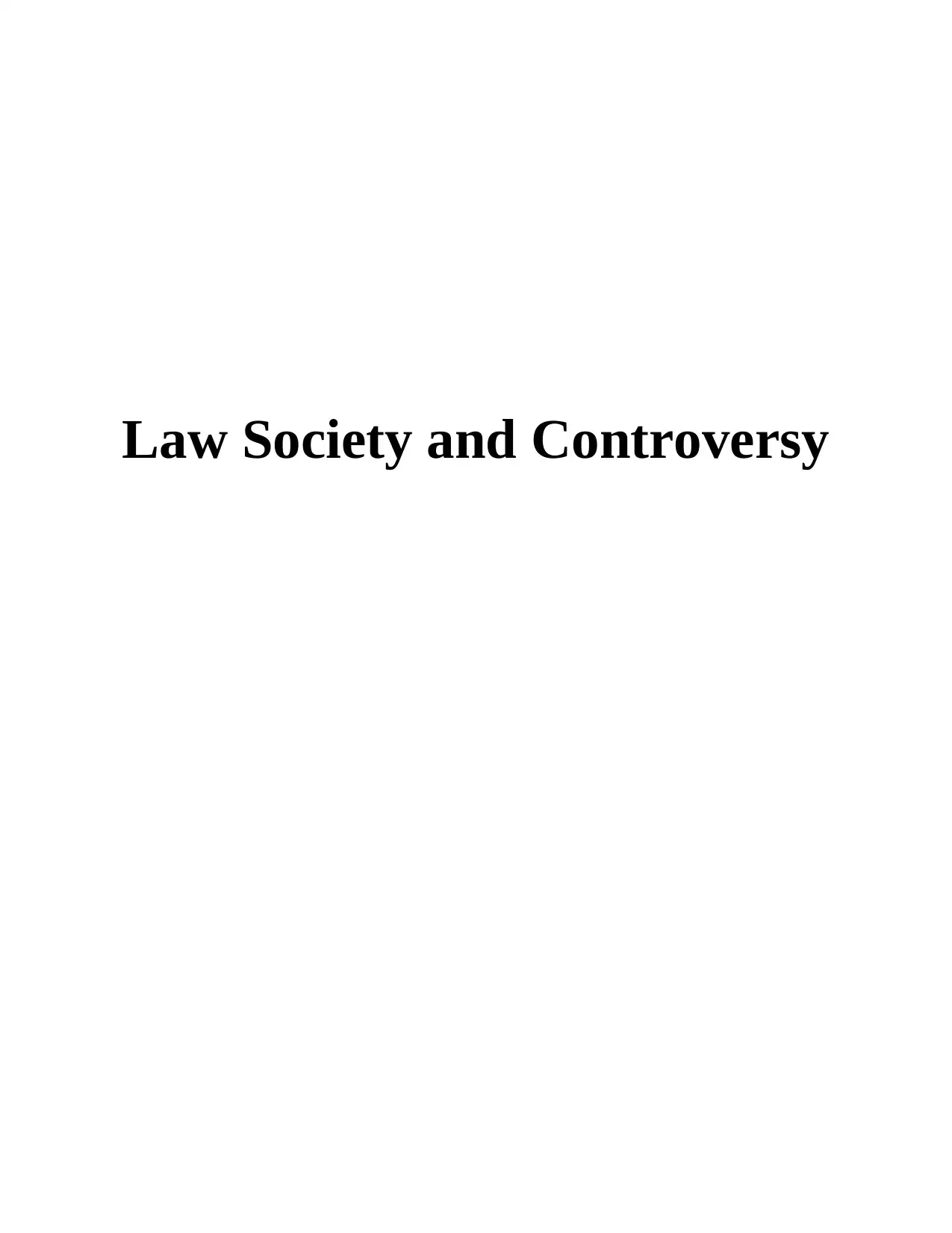
Law Society and Controversy
Paraphrase This Document
Need a fresh take? Get an instant paraphrase of this document with our AI Paraphraser
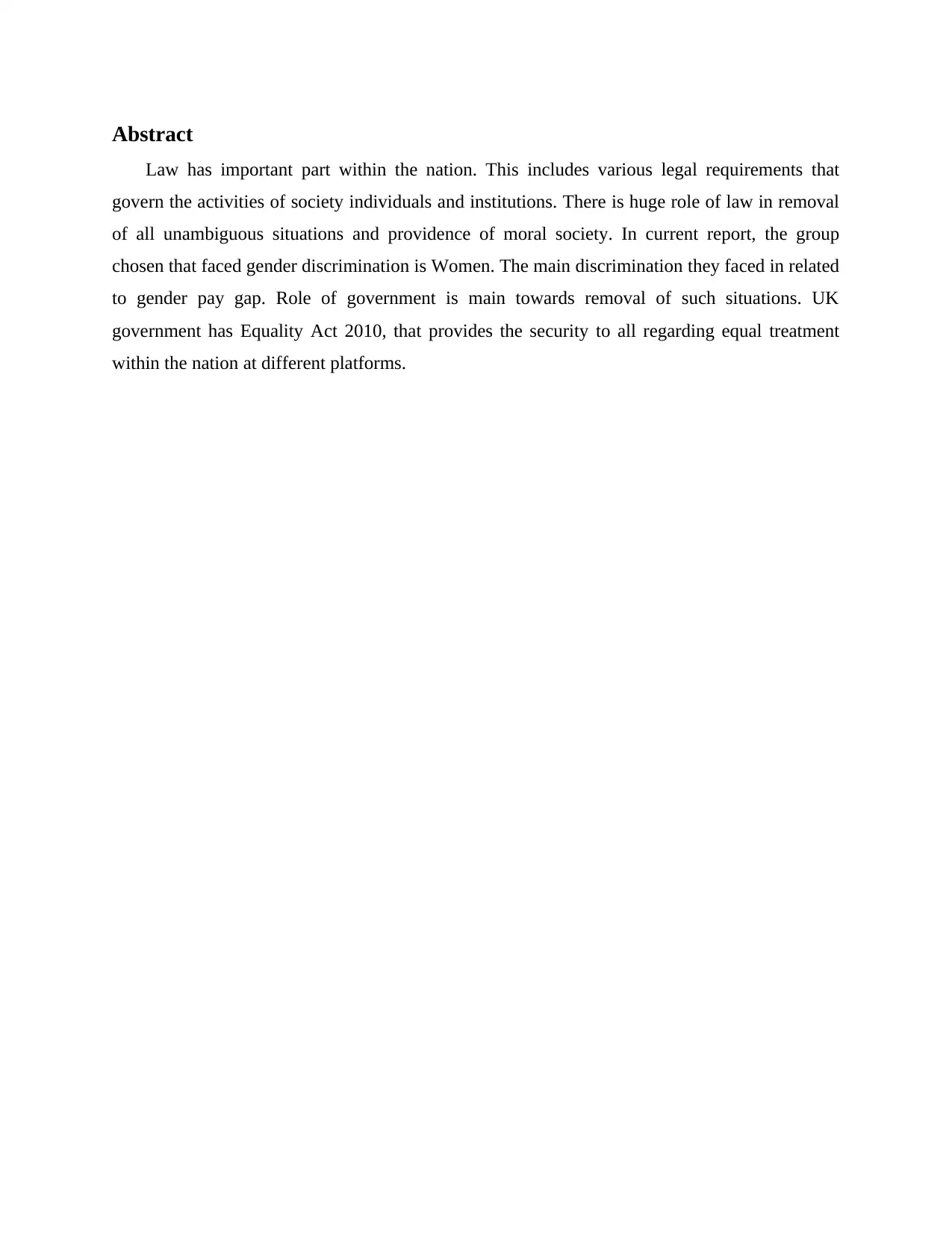
Abstract
Law has important part within the nation. This includes various legal requirements that
govern the activities of society individuals and institutions. There is huge role of law in removal
of all unambiguous situations and providence of moral society. In current report, the group
chosen that faced gender discrimination is Women. The main discrimination they faced in related
to gender pay gap. Role of government is main towards removal of such situations. UK
government has Equality Act 2010, that provides the security to all regarding equal treatment
within the nation at different platforms.
Law has important part within the nation. This includes various legal requirements that
govern the activities of society individuals and institutions. There is huge role of law in removal
of all unambiguous situations and providence of moral society. In current report, the group
chosen that faced gender discrimination is Women. The main discrimination they faced in related
to gender pay gap. Role of government is main towards removal of such situations. UK
government has Equality Act 2010, that provides the security to all regarding equal treatment
within the nation at different platforms.
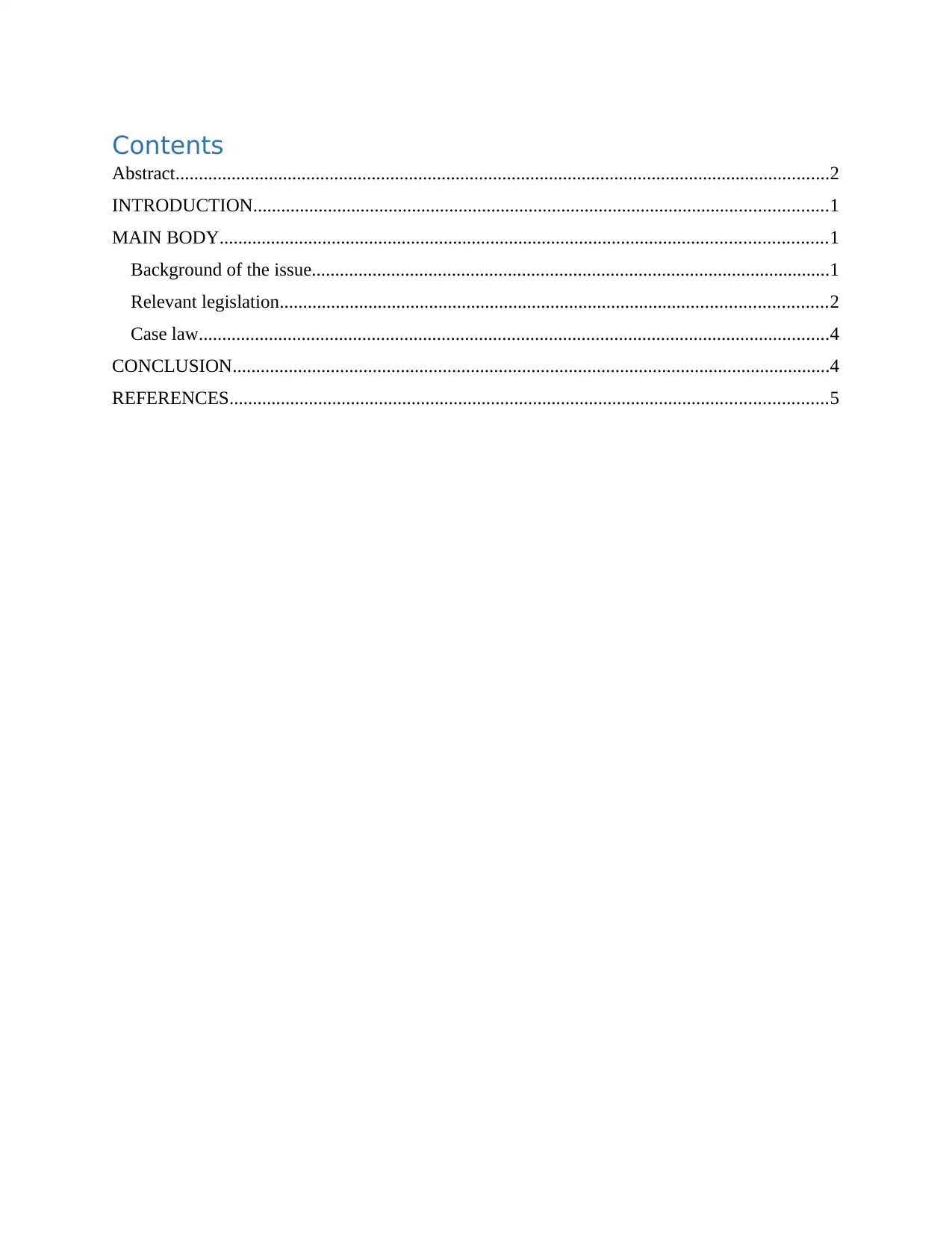
Contents
Abstract............................................................................................................................................2
INTRODUCTION...........................................................................................................................1
MAIN BODY..................................................................................................................................1
Background of the issue...............................................................................................................1
Relevant legislation.....................................................................................................................2
Case law.......................................................................................................................................4
CONCLUSION................................................................................................................................4
REFERENCES................................................................................................................................5
Abstract............................................................................................................................................2
INTRODUCTION...........................................................................................................................1
MAIN BODY..................................................................................................................................1
Background of the issue...............................................................................................................1
Relevant legislation.....................................................................................................................2
Case law.......................................................................................................................................4
CONCLUSION................................................................................................................................4
REFERENCES................................................................................................................................5
⊘ This is a preview!⊘
Do you want full access?
Subscribe today to unlock all pages.

Trusted by 1+ million students worldwide
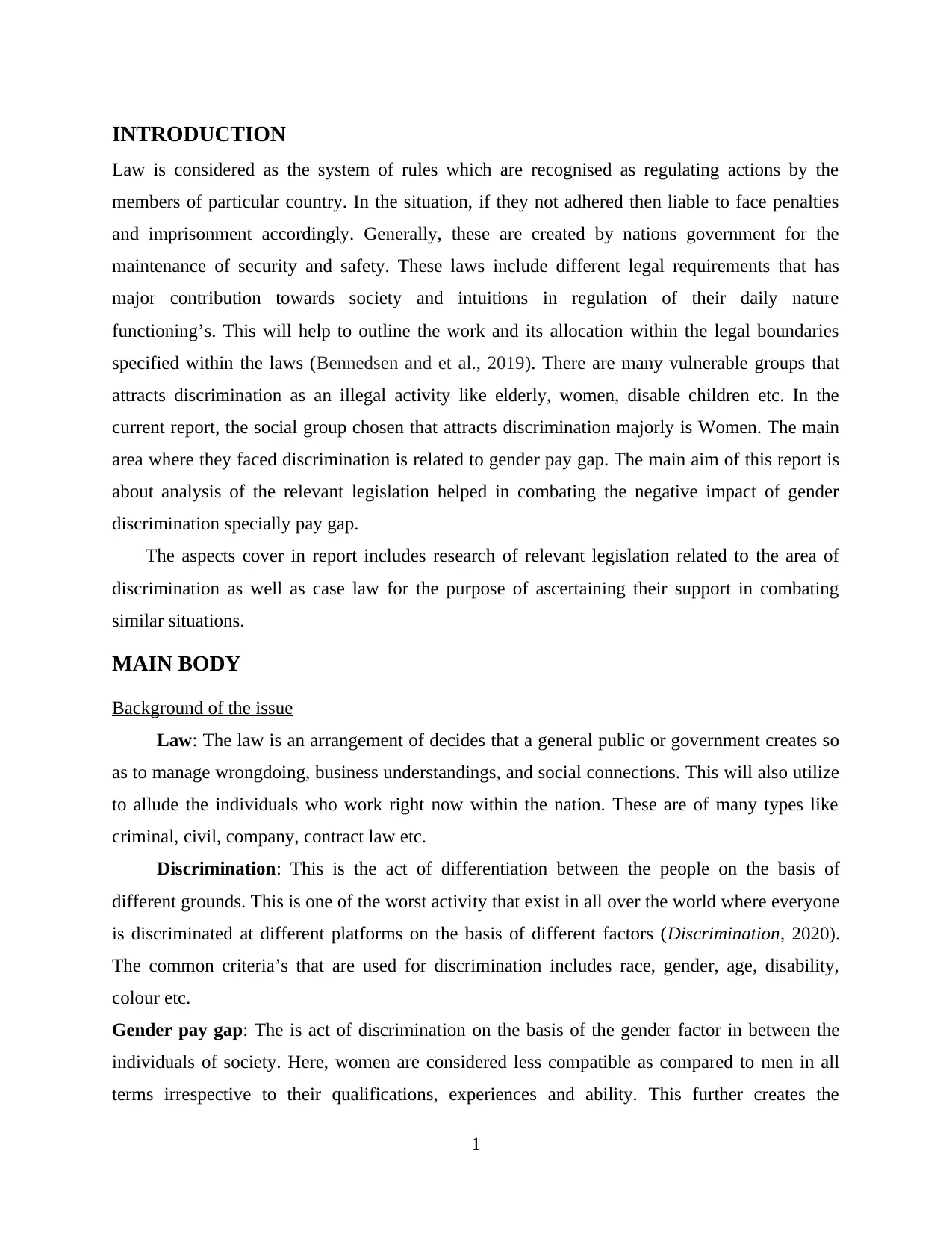
INTRODUCTION
Law is considered as the system of rules which are recognised as regulating actions by the
members of particular country. In the situation, if they not adhered then liable to face penalties
and imprisonment accordingly. Generally, these are created by nations government for the
maintenance of security and safety. These laws include different legal requirements that has
major contribution towards society and intuitions in regulation of their daily nature
functioning’s. This will help to outline the work and its allocation within the legal boundaries
specified within the laws (Bennedsen and et al., 2019). There are many vulnerable groups that
attracts discrimination as an illegal activity like elderly, women, disable children etc. In the
current report, the social group chosen that attracts discrimination majorly is Women. The main
area where they faced discrimination is related to gender pay gap. The main aim of this report is
about analysis of the relevant legislation helped in combating the negative impact of gender
discrimination specially pay gap.
The aspects cover in report includes research of relevant legislation related to the area of
discrimination as well as case law for the purpose of ascertaining their support in combating
similar situations.
MAIN BODY
Background of the issue
Law: The law is an arrangement of decides that a general public or government creates so
as to manage wrongdoing, business understandings, and social connections. This will also utilize
to allude the individuals who work right now within the nation. These are of many types like
criminal, civil, company, contract law etc.
Discrimination: This is the act of differentiation between the people on the basis of
different grounds. This is one of the worst activity that exist in all over the world where everyone
is discriminated at different platforms on the basis of different factors (Discrimination, 2020).
The common criteria’s that are used for discrimination includes race, gender, age, disability,
colour etc.
Gender pay gap: The is act of discrimination on the basis of the gender factor in between the
individuals of society. Here, women are considered less compatible as compared to men in all
terms irrespective to their qualifications, experiences and ability. This further creates the
1
Law is considered as the system of rules which are recognised as regulating actions by the
members of particular country. In the situation, if they not adhered then liable to face penalties
and imprisonment accordingly. Generally, these are created by nations government for the
maintenance of security and safety. These laws include different legal requirements that has
major contribution towards society and intuitions in regulation of their daily nature
functioning’s. This will help to outline the work and its allocation within the legal boundaries
specified within the laws (Bennedsen and et al., 2019). There are many vulnerable groups that
attracts discrimination as an illegal activity like elderly, women, disable children etc. In the
current report, the social group chosen that attracts discrimination majorly is Women. The main
area where they faced discrimination is related to gender pay gap. The main aim of this report is
about analysis of the relevant legislation helped in combating the negative impact of gender
discrimination specially pay gap.
The aspects cover in report includes research of relevant legislation related to the area of
discrimination as well as case law for the purpose of ascertaining their support in combating
similar situations.
MAIN BODY
Background of the issue
Law: The law is an arrangement of decides that a general public or government creates so
as to manage wrongdoing, business understandings, and social connections. This will also utilize
to allude the individuals who work right now within the nation. These are of many types like
criminal, civil, company, contract law etc.
Discrimination: This is the act of differentiation between the people on the basis of
different grounds. This is one of the worst activity that exist in all over the world where everyone
is discriminated at different platforms on the basis of different factors (Discrimination, 2020).
The common criteria’s that are used for discrimination includes race, gender, age, disability,
colour etc.
Gender pay gap: The is act of discrimination on the basis of the gender factor in between the
individuals of society. Here, women are considered less compatible as compared to men in all
terms irrespective to their qualifications, experiences and ability. This further creates the
1
Paraphrase This Document
Need a fresh take? Get an instant paraphrase of this document with our AI Paraphraser
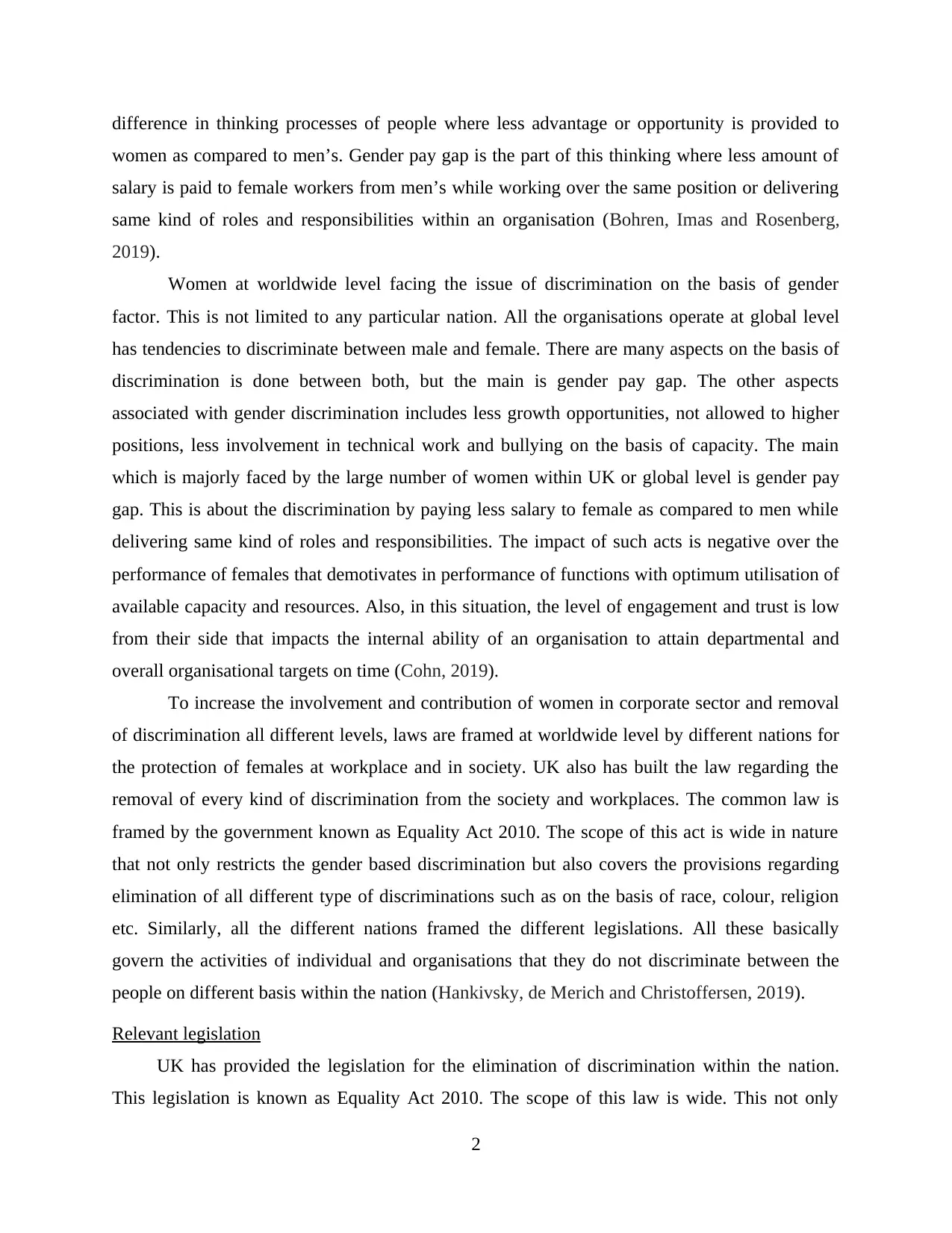
difference in thinking processes of people where less advantage or opportunity is provided to
women as compared to men’s. Gender pay gap is the part of this thinking where less amount of
salary is paid to female workers from men’s while working over the same position or delivering
same kind of roles and responsibilities within an organisation (Bohren, Imas and Rosenberg,
2019).
Women at worldwide level facing the issue of discrimination on the basis of gender
factor. This is not limited to any particular nation. All the organisations operate at global level
has tendencies to discriminate between male and female. There are many aspects on the basis of
discrimination is done between both, but the main is gender pay gap. The other aspects
associated with gender discrimination includes less growth opportunities, not allowed to higher
positions, less involvement in technical work and bullying on the basis of capacity. The main
which is majorly faced by the large number of women within UK or global level is gender pay
gap. This is about the discrimination by paying less salary to female as compared to men while
delivering same kind of roles and responsibilities. The impact of such acts is negative over the
performance of females that demotivates in performance of functions with optimum utilisation of
available capacity and resources. Also, in this situation, the level of engagement and trust is low
from their side that impacts the internal ability of an organisation to attain departmental and
overall organisational targets on time (Cohn, 2019).
To increase the involvement and contribution of women in corporate sector and removal
of discrimination all different levels, laws are framed at worldwide level by different nations for
the protection of females at workplace and in society. UK also has built the law regarding the
removal of every kind of discrimination from the society and workplaces. The common law is
framed by the government known as Equality Act 2010. The scope of this act is wide in nature
that not only restricts the gender based discrimination but also covers the provisions regarding
elimination of all different type of discriminations such as on the basis of race, colour, religion
etc. Similarly, all the different nations framed the different legislations. All these basically
govern the activities of individual and organisations that they do not discriminate between the
people on different basis within the nation (Hankivsky, de Merich and Christoffersen, 2019).
Relevant legislation
UK has provided the legislation for the elimination of discrimination within the nation.
This legislation is known as Equality Act 2010. The scope of this law is wide. This not only
2
women as compared to men’s. Gender pay gap is the part of this thinking where less amount of
salary is paid to female workers from men’s while working over the same position or delivering
same kind of roles and responsibilities within an organisation (Bohren, Imas and Rosenberg,
2019).
Women at worldwide level facing the issue of discrimination on the basis of gender
factor. This is not limited to any particular nation. All the organisations operate at global level
has tendencies to discriminate between male and female. There are many aspects on the basis of
discrimination is done between both, but the main is gender pay gap. The other aspects
associated with gender discrimination includes less growth opportunities, not allowed to higher
positions, less involvement in technical work and bullying on the basis of capacity. The main
which is majorly faced by the large number of women within UK or global level is gender pay
gap. This is about the discrimination by paying less salary to female as compared to men while
delivering same kind of roles and responsibilities. The impact of such acts is negative over the
performance of females that demotivates in performance of functions with optimum utilisation of
available capacity and resources. Also, in this situation, the level of engagement and trust is low
from their side that impacts the internal ability of an organisation to attain departmental and
overall organisational targets on time (Cohn, 2019).
To increase the involvement and contribution of women in corporate sector and removal
of discrimination all different levels, laws are framed at worldwide level by different nations for
the protection of females at workplace and in society. UK also has built the law regarding the
removal of every kind of discrimination from the society and workplaces. The common law is
framed by the government known as Equality Act 2010. The scope of this act is wide in nature
that not only restricts the gender based discrimination but also covers the provisions regarding
elimination of all different type of discriminations such as on the basis of race, colour, religion
etc. Similarly, all the different nations framed the different legislations. All these basically
govern the activities of individual and organisations that they do not discriminate between the
people on different basis within the nation (Hankivsky, de Merich and Christoffersen, 2019).
Relevant legislation
UK has provided the legislation for the elimination of discrimination within the nation.
This legislation is known as Equality Act 2010. The scope of this law is wide. This not only
2
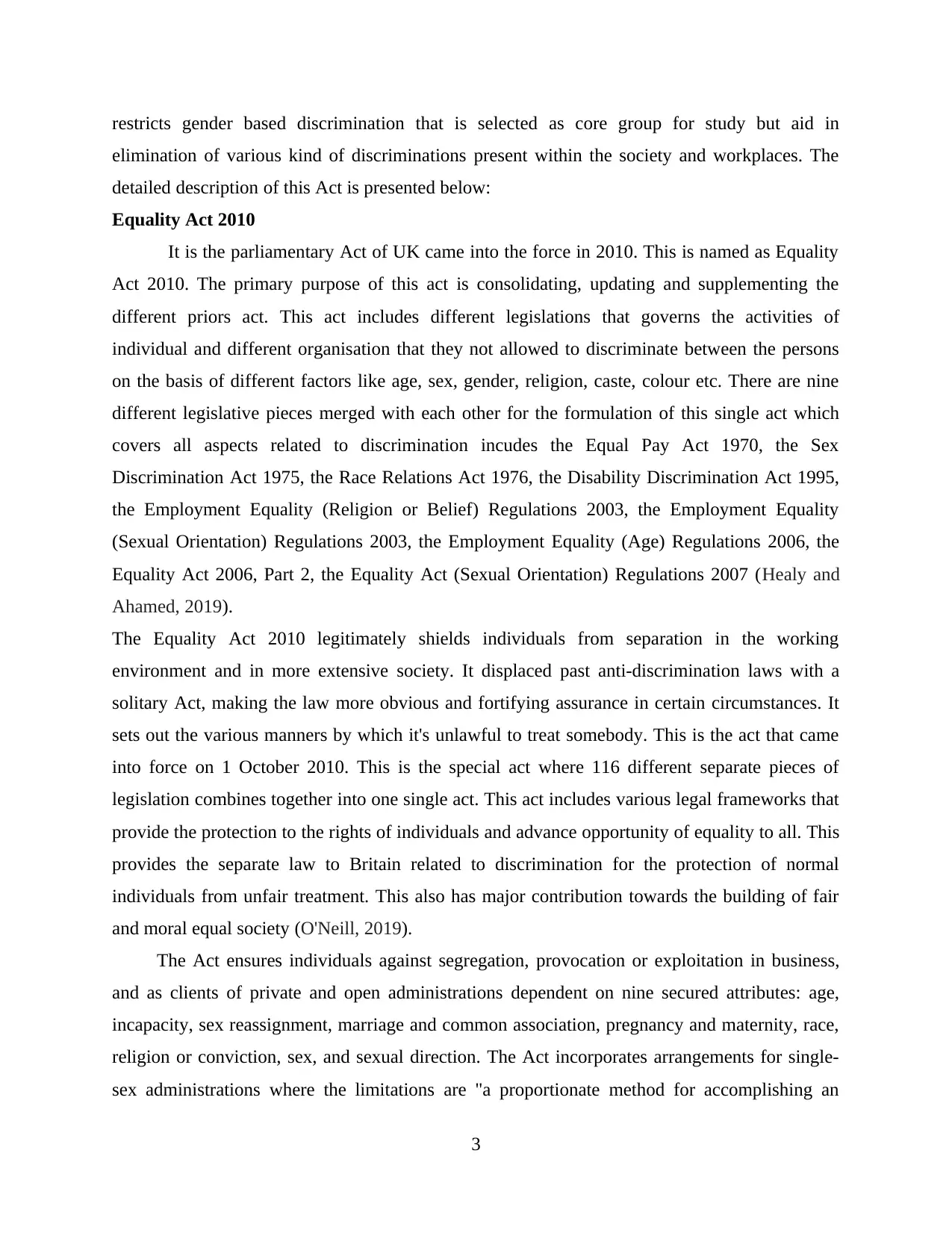
restricts gender based discrimination that is selected as core group for study but aid in
elimination of various kind of discriminations present within the society and workplaces. The
detailed description of this Act is presented below:
Equality Act 2010
It is the parliamentary Act of UK came into the force in 2010. This is named as Equality
Act 2010. The primary purpose of this act is consolidating, updating and supplementing the
different priors act. This act includes different legislations that governs the activities of
individual and different organisation that they not allowed to discriminate between the persons
on the basis of different factors like age, sex, gender, religion, caste, colour etc. There are nine
different legislative pieces merged with each other for the formulation of this single act which
covers all aspects related to discrimination incudes the Equal Pay Act 1970, the Sex
Discrimination Act 1975, the Race Relations Act 1976, the Disability Discrimination Act 1995,
the Employment Equality (Religion or Belief) Regulations 2003, the Employment Equality
(Sexual Orientation) Regulations 2003, the Employment Equality (Age) Regulations 2006, the
Equality Act 2006, Part 2, the Equality Act (Sexual Orientation) Regulations 2007 (Healy and
Ahamed, 2019).
The Equality Act 2010 legitimately shields individuals from separation in the working
environment and in more extensive society. It displaced past anti-discrimination laws with a
solitary Act, making the law more obvious and fortifying assurance in certain circumstances. It
sets out the various manners by which it's unlawful to treat somebody. This is the act that came
into force on 1 October 2010. This is the special act where 116 different separate pieces of
legislation combines together into one single act. This act includes various legal frameworks that
provide the protection to the rights of individuals and advance opportunity of equality to all. This
provides the separate law to Britain related to discrimination for the protection of normal
individuals from unfair treatment. This also has major contribution towards the building of fair
and moral equal society (O'Neill, 2019).
The Act ensures individuals against segregation, provocation or exploitation in business,
and as clients of private and open administrations dependent on nine secured attributes: age,
incapacity, sex reassignment, marriage and common association, pregnancy and maternity, race,
religion or conviction, sex, and sexual direction. The Act incorporates arrangements for single-
sex administrations where the limitations are "a proportionate method for accomplishing an
3
elimination of various kind of discriminations present within the society and workplaces. The
detailed description of this Act is presented below:
Equality Act 2010
It is the parliamentary Act of UK came into the force in 2010. This is named as Equality
Act 2010. The primary purpose of this act is consolidating, updating and supplementing the
different priors act. This act includes different legislations that governs the activities of
individual and different organisation that they not allowed to discriminate between the persons
on the basis of different factors like age, sex, gender, religion, caste, colour etc. There are nine
different legislative pieces merged with each other for the formulation of this single act which
covers all aspects related to discrimination incudes the Equal Pay Act 1970, the Sex
Discrimination Act 1975, the Race Relations Act 1976, the Disability Discrimination Act 1995,
the Employment Equality (Religion or Belief) Regulations 2003, the Employment Equality
(Sexual Orientation) Regulations 2003, the Employment Equality (Age) Regulations 2006, the
Equality Act 2006, Part 2, the Equality Act (Sexual Orientation) Regulations 2007 (Healy and
Ahamed, 2019).
The Equality Act 2010 legitimately shields individuals from separation in the working
environment and in more extensive society. It displaced past anti-discrimination laws with a
solitary Act, making the law more obvious and fortifying assurance in certain circumstances. It
sets out the various manners by which it's unlawful to treat somebody. This is the act that came
into force on 1 October 2010. This is the special act where 116 different separate pieces of
legislation combines together into one single act. This act includes various legal frameworks that
provide the protection to the rights of individuals and advance opportunity of equality to all. This
provides the separate law to Britain related to discrimination for the protection of normal
individuals from unfair treatment. This also has major contribution towards the building of fair
and moral equal society (O'Neill, 2019).
The Act ensures individuals against segregation, provocation or exploitation in business,
and as clients of private and open administrations dependent on nine secured attributes: age,
incapacity, sex reassignment, marriage and common association, pregnancy and maternity, race,
religion or conviction, sex, and sexual direction. The Act incorporates arrangements for single-
sex administrations where the limitations are "a proportionate method for accomplishing an
3
⊘ This is a preview!⊘
Do you want full access?
Subscribe today to unlock all pages.

Trusted by 1+ million students worldwide
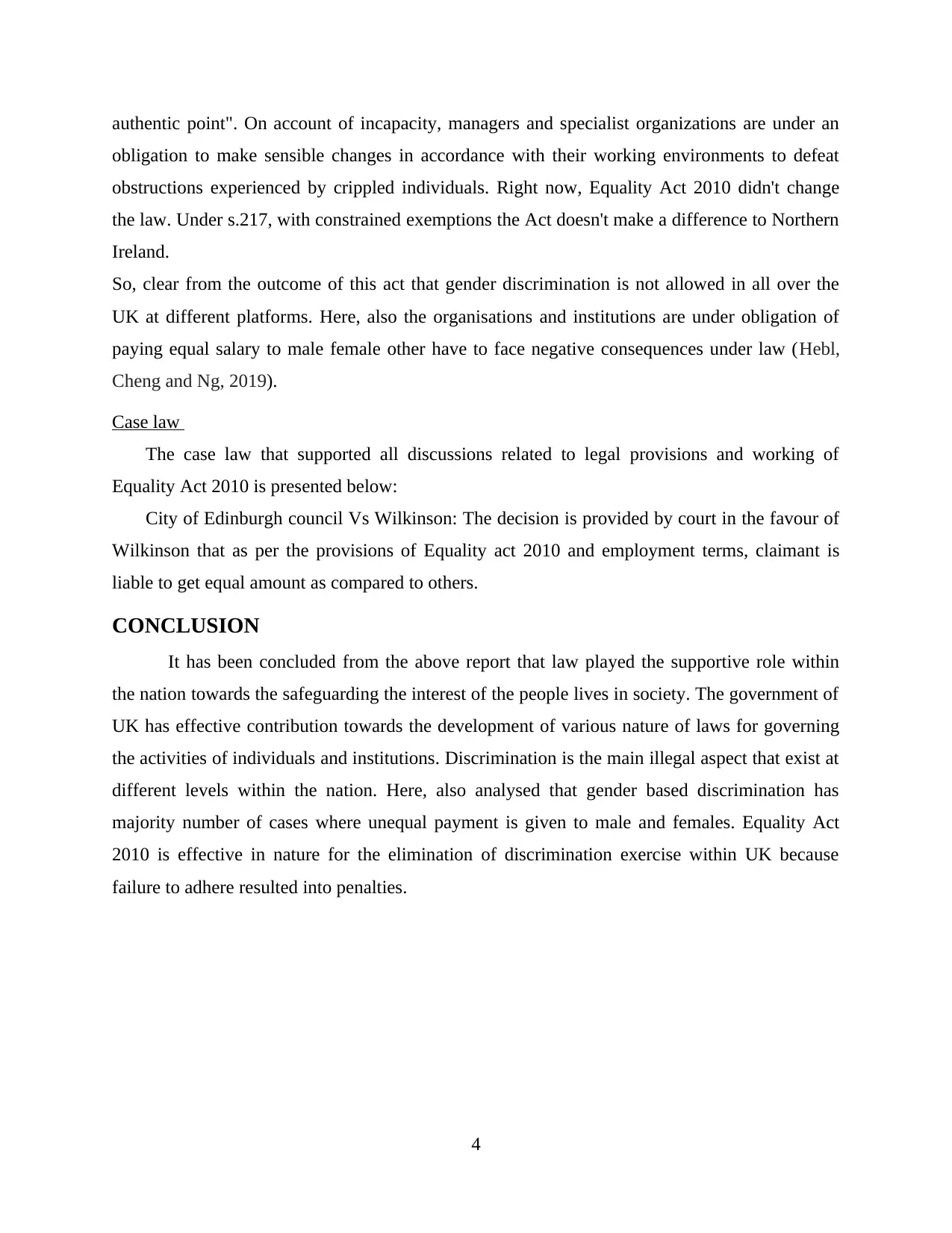
authentic point". On account of incapacity, managers and specialist organizations are under an
obligation to make sensible changes in accordance with their working environments to defeat
obstructions experienced by crippled individuals. Right now, Equality Act 2010 didn't change
the law. Under s.217, with constrained exemptions the Act doesn't make a difference to Northern
Ireland.
So, clear from the outcome of this act that gender discrimination is not allowed in all over the
UK at different platforms. Here, also the organisations and institutions are under obligation of
paying equal salary to male female other have to face negative consequences under law (Hebl,
Cheng and Ng, 2019).
Case law
The case law that supported all discussions related to legal provisions and working of
Equality Act 2010 is presented below:
City of Edinburgh council Vs Wilkinson: The decision is provided by court in the favour of
Wilkinson that as per the provisions of Equality act 2010 and employment terms, claimant is
liable to get equal amount as compared to others.
CONCLUSION
It has been concluded from the above report that law played the supportive role within
the nation towards the safeguarding the interest of the people lives in society. The government of
UK has effective contribution towards the development of various nature of laws for governing
the activities of individuals and institutions. Discrimination is the main illegal aspect that exist at
different levels within the nation. Here, also analysed that gender based discrimination has
majority number of cases where unequal payment is given to male and females. Equality Act
2010 is effective in nature for the elimination of discrimination exercise within UK because
failure to adhere resulted into penalties.
4
obligation to make sensible changes in accordance with their working environments to defeat
obstructions experienced by crippled individuals. Right now, Equality Act 2010 didn't change
the law. Under s.217, with constrained exemptions the Act doesn't make a difference to Northern
Ireland.
So, clear from the outcome of this act that gender discrimination is not allowed in all over the
UK at different platforms. Here, also the organisations and institutions are under obligation of
paying equal salary to male female other have to face negative consequences under law (Hebl,
Cheng and Ng, 2019).
Case law
The case law that supported all discussions related to legal provisions and working of
Equality Act 2010 is presented below:
City of Edinburgh council Vs Wilkinson: The decision is provided by court in the favour of
Wilkinson that as per the provisions of Equality act 2010 and employment terms, claimant is
liable to get equal amount as compared to others.
CONCLUSION
It has been concluded from the above report that law played the supportive role within
the nation towards the safeguarding the interest of the people lives in society. The government of
UK has effective contribution towards the development of various nature of laws for governing
the activities of individuals and institutions. Discrimination is the main illegal aspect that exist at
different levels within the nation. Here, also analysed that gender based discrimination has
majority number of cases where unequal payment is given to male and females. Equality Act
2010 is effective in nature for the elimination of discrimination exercise within UK because
failure to adhere resulted into penalties.
4
Paraphrase This Document
Need a fresh take? Get an instant paraphrase of this document with our AI Paraphraser
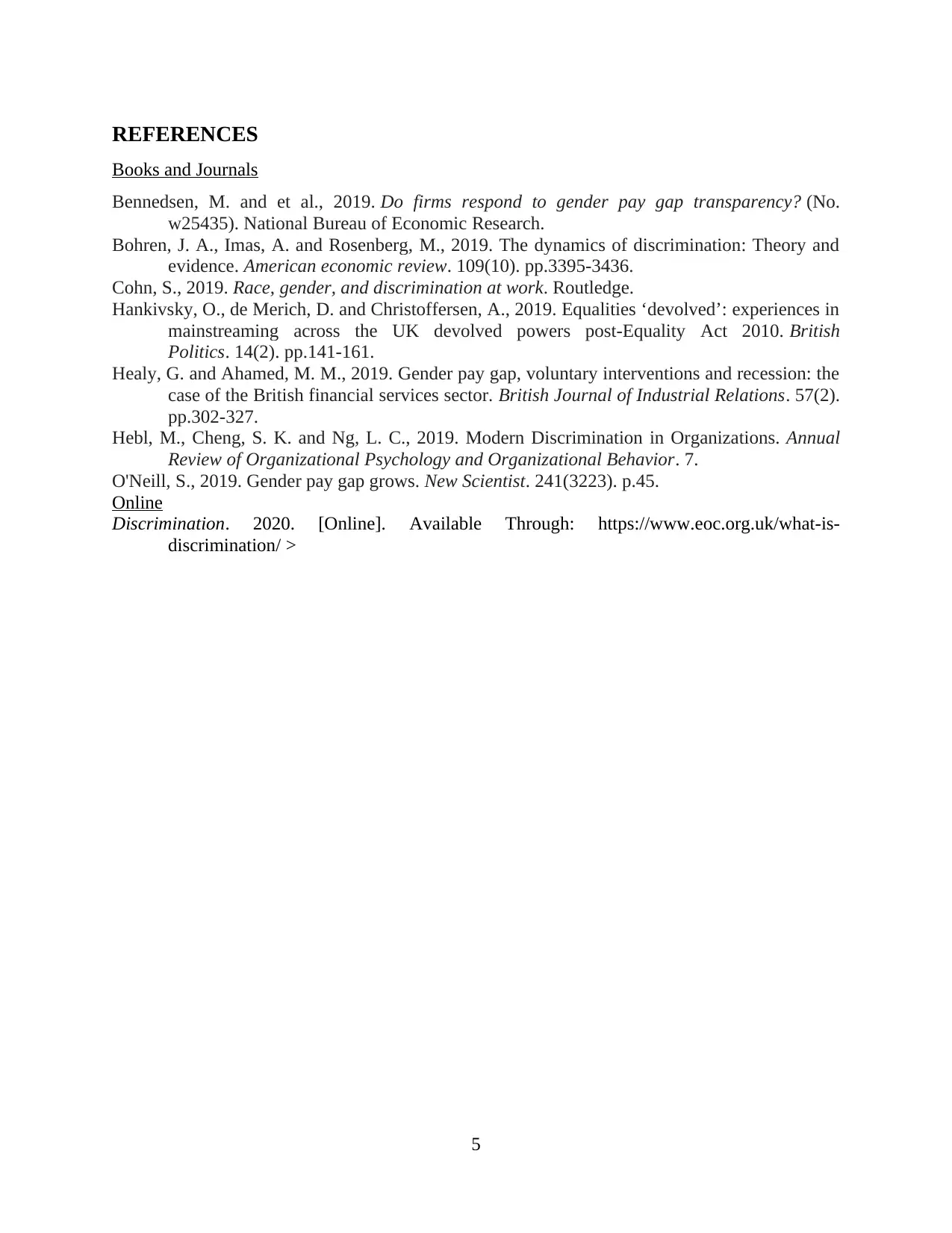
REFERENCES
Books and Journals
Bennedsen, M. and et al., 2019. Do firms respond to gender pay gap transparency? (No.
w25435). National Bureau of Economic Research.
Bohren, J. A., Imas, A. and Rosenberg, M., 2019. The dynamics of discrimination: Theory and
evidence. American economic review. 109(10). pp.3395-3436.
Cohn, S., 2019. Race, gender, and discrimination at work. Routledge.
Hankivsky, O., de Merich, D. and Christoffersen, A., 2019. Equalities ‘devolved’: experiences in
mainstreaming across the UK devolved powers post-Equality Act 2010. British
Politics. 14(2). pp.141-161.
Healy, G. and Ahamed, M. M., 2019. Gender pay gap, voluntary interventions and recession: the
case of the British financial services sector. British Journal of Industrial Relations. 57(2).
pp.302-327.
Hebl, M., Cheng, S. K. and Ng, L. C., 2019. Modern Discrimination in Organizations. Annual
Review of Organizational Psychology and Organizational Behavior. 7.
O'Neill, S., 2019. Gender pay gap grows. New Scientist. 241(3223). p.45.
Online
Discrimination. 2020. [Online]. Available Through: https://www.eoc.org.uk/what-is-
discrimination/ >
5
Books and Journals
Bennedsen, M. and et al., 2019. Do firms respond to gender pay gap transparency? (No.
w25435). National Bureau of Economic Research.
Bohren, J. A., Imas, A. and Rosenberg, M., 2019. The dynamics of discrimination: Theory and
evidence. American economic review. 109(10). pp.3395-3436.
Cohn, S., 2019. Race, gender, and discrimination at work. Routledge.
Hankivsky, O., de Merich, D. and Christoffersen, A., 2019. Equalities ‘devolved’: experiences in
mainstreaming across the UK devolved powers post-Equality Act 2010. British
Politics. 14(2). pp.141-161.
Healy, G. and Ahamed, M. M., 2019. Gender pay gap, voluntary interventions and recession: the
case of the British financial services sector. British Journal of Industrial Relations. 57(2).
pp.302-327.
Hebl, M., Cheng, S. K. and Ng, L. C., 2019. Modern Discrimination in Organizations. Annual
Review of Organizational Psychology and Organizational Behavior. 7.
O'Neill, S., 2019. Gender pay gap grows. New Scientist. 241(3223). p.45.
Online
Discrimination. 2020. [Online]. Available Through: https://www.eoc.org.uk/what-is-
discrimination/ >
5
1 out of 8
Related Documents
Your All-in-One AI-Powered Toolkit for Academic Success.
+13062052269
info@desklib.com
Available 24*7 on WhatsApp / Email
![[object Object]](/_next/static/media/star-bottom.7253800d.svg)
Unlock your academic potential
Copyright © 2020–2025 A2Z Services. All Rights Reserved. Developed and managed by ZUCOL.




